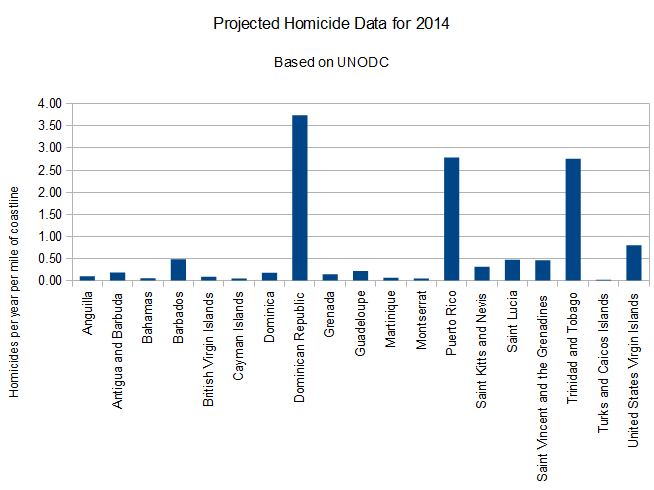Last week, a British man was murdered on the Caribbean Island of St Lucia.
I’ll be honest, that scared me a little. In about 9 months, I am taking my wife and three boys to the Caribbean, and had pondered St Lucia on our itinerary. Can I keep them safe?
Since the incident, there has been a large amount of emotional debate on sailing forums. It’s touched on should you carry guns to defend yourself, to what islands should you avoid. With the high profile homicide all over the news, there will probably be a direct impact of many millions of dollars in tourism revenue for St Lucia, for a country that desperately needs it.
But is it safe?
Well, maybe not. I wanted to find out.
A quick read of blog posts, forums and comments quickly shows that most peoples opinions are based in anecdotal evidence. If they have been trouble free, they think that islands is fine to visit, and vice versa. So, we need some better information.
The data that all those high end news outlets are quoting is the 2011 Global Study on Homicide from the United Nations Office on Drugs and Crime (UNDOC). Amazingly, these news outlets are reporting homicide rates per 100,000 for the last year that data existed.
That’s bogus.
Let’s take Montserrat, with a worryingly high figure of 19.7 homicides per 100,000 population! Miami in 2011 was 16.8. So you’d be better walking the dark streets of Miami than this topical paradise island?
Well, when you look at the UNDOC data, you’ll see this:
| 1995 | 1996 | 1997 | 1998 | 1999 | 2000 | 2001 | 2002 | 2003 | 2004 | 2005 | 2006 | 2007 | 2008 | ||
| Montserrat | Rate | 12.6 | 0.0 | 29.6 | 0.0 | 0.0 | 0.0 | 0.0 | 0.0 | 22.1 | 21.6 | 19.7 | |||
| Montserrat | Actual | 1 | 0 | 2 | 0 | 0 | 0 | 0 | 0 | 1 | 1 | 1 |
The first thing we see is that the last data was in 2008, that’s 5 years ago! The second is that the gang-like homicide rate is just due to a single homicide.
So, first thing to do is to do a regression out to 2014. In Homicide_statistics2013 is all my analysis.
But the rate isn’t really that useful, so we need a better measure. First consider what a homicide rate implies. It’s not really a predictor of what crimes are committed against tourists, it’s mostly a (very) coarse measure of the lethal crimes in that country. The first step is to convert rates to absolute numbers. One then has to think of how these might be distributed across the country/island. At first, one might consider using area. That would give a coarse comparison of “what’s your chance of walking into trouble?” But, as sailors, let’s assume we stay (mostly) to the coastline. Many of the countries are islands chains, or strange shapes. This means that their “sailor contact area”, i.e. the coastline, doesn’t correlate well to the area. So, I looked up actual coastline lengths to make a correction for this to give the rates above.

This gives, for Monserrat for example, 0.04 homicides per year per mile of coastline. Now this doesn’t mean that, Trinidad has over 2 murders per mile of coast. It DOES mean that Trinidad is probably more dangerous than the British Virgin Islands. Its a comparative measure.
As the first measure, we score the islands 1-3. A 1 means it’s relatively low homicide rates, a 3 means it’s a little iffy.
Now, unlike other news outlets, we don’t stop here. Most of these homicides are not against tourists, it’s just one factor we can consider.
The Fed’s Advice
“The State Department’s Office of American Citizens Services and Crisis Management (ACS) administers the Consular Information Program, which informs the public of conditions abroad that may affect their safety and security.”
That sounds good. Let’s compare the narrative statements and warnings that the US government gives to its citizens to warn them of potential danger. For example, compare these two:
While Montserrat’s crime rate is relatively low, both petty and violent crimes do occur.
St Kitts: The government is currently working to combat an influx of illegal weapons onto the islands. Violent crime—including murder, petty street crime, automobile break-ins and burglary—continue to occur.
Yes, we can definitely see a distinct difference.
Let’s put them in a table to compare, and again, give them a score:
3=Violent Crime
2= Some Violent Crime or Frequent Petty Crime
1=Petty Crime
Again, I am not saying these are the final arbitrator, they are just another data point.
Actual Sailor Reports from Noonsite
So far we have only considered general crime data. Connected to Noonsite.com there is the Caribbean Safety and Security Net which also collects reports from the sailing community about all range of incidents. We can add up the total number of incidents that have been reported over the last few year, for example:
St Kitts=3
St Lucia=43
Again, we can give a rating from 1 to 3 based on the frequency of reports. Of course, these are self selected reporting. Where there are more sailors, there will be more reports, but not necessarily more incidents per sailor. But it’s just another data point.
The Safest and Most Dangerous Caribbean Islands
The result is a simple ranking from safest to least, taking a diverse range of data.
| Rating Based on Embassy Reports | Rating Based on Homicide Rate | Rating Based on Noonsite Reports | Total Score | |
| Anguilla | 1 | 1 | 1 | 3 |
| Cayman Islands | 1 | 1 | 1 | 3 |
| Dominica | 1 | 1 | 1 | 3 |
| Guadaloupe | 1 | 1 | 1 | 3 |
| Montserrat | 1 | 1 | 1 | 3 |
| St Martin (French) | 1 | 1 | 1 | 3 |
| Turks and Caicos Islands | 1 | 1 | 1 | 3 |
| Antigua and Barbuda | 2 | 1 | 1 | 4 |
| Barbados | 1 | 2 | 1 | 4 |
| Martinique | 1 | 1 | 2 | 4 |
| St Kitts | 2 | 1 | 1 | 4 |
| St Maartan | 2 | 1 | 1 | 4 |
| USVI | 1 | 2 | 1 | 4 |
| Bahamas | 3 | 1 | 1 | 5 |
| BVI | 2 | 1 | 2 | 5 |
| Grenada | 1 | 1 | 3 | 5 |
| Dominican Republic | 2 | 3 | 1 | 6 |
| Puerto Rico | 2 | 3 | 2 | 7 |
| St Lucia | 2 | 2 | 3 | 7 |
| St Vincent | 2 | 2 | 3 | 7 |
| Trinidad | 3 | 3 | 3 | 9 |
The real data we need is crime committed against sailors per mile of coastline. That would give your your “incidence density.”
We can get this approximation though. Being aware of the “signal vs noise” in our data, we have to squint at this table. The basic conclusion is probably that most Caribbean islands are safe to travel, but if you visit Puerto Rico, St Lucia, St Vincent, Trinidad you should do so with care.
The unfortunate part is that clearly, looking at local news websites in St Lucia, locals there are as outraged as visitors with the crime.
As for me, I’ll be adjusting my itinerary, installing some basic boat safety equipment, and trying to keep my family safe.
What will you be doing, please comment below.
Update
Commuter Cruiser has two great posts about safety:
http://commutercruiser.com/15-tips-for-tilting-safety-odds-in-your-favor
http://commutercruiser.com/outfitting-for-security
More Updates
Noonsite has released a report with its Caribbean Safety Index (CSI)
http://freecruisingguides.com/guides/CSI%20Update4_2014.01.pdf


We have spent the last 6 years cruising the Caribbean. The first year we visited every island and now we just visit the ones we consider safe.
If, from our anecdotal position, we had sat down over a bottle of wine and tried to create the above list we would have created an identical list within 90% confidence limits.
Nice to see a semi-quantitative approach agrees with our experience.
Phil, a Yorkshireman married to a Hispanic New Yorker…
LikeLike
Hi Phil,
That’s interesting that your experiences match up to what I found. Gives me some confidence in my findings…
LikeLike
Barrie,
What happens when you apply the method to Venezuela, Columbia, Panama and other Hispanic countries? We rate them more dangerous than the Caribbean Islands including Trinidad.
LikeLike
I can imagine they would also be flagged to be as cautious as Trinidad…
LikeLike
How does Jamaica rank? Booked a trip in May but am seriously reconsidering it after reading some things about violence, corrupt police and lack of security/theft within resorts.
LikeLike
I didn’t include Jamaica as it was off our route. My understanding, based in no real expertise, is that it’s a mixed bag depending on where you go.
LikeLike